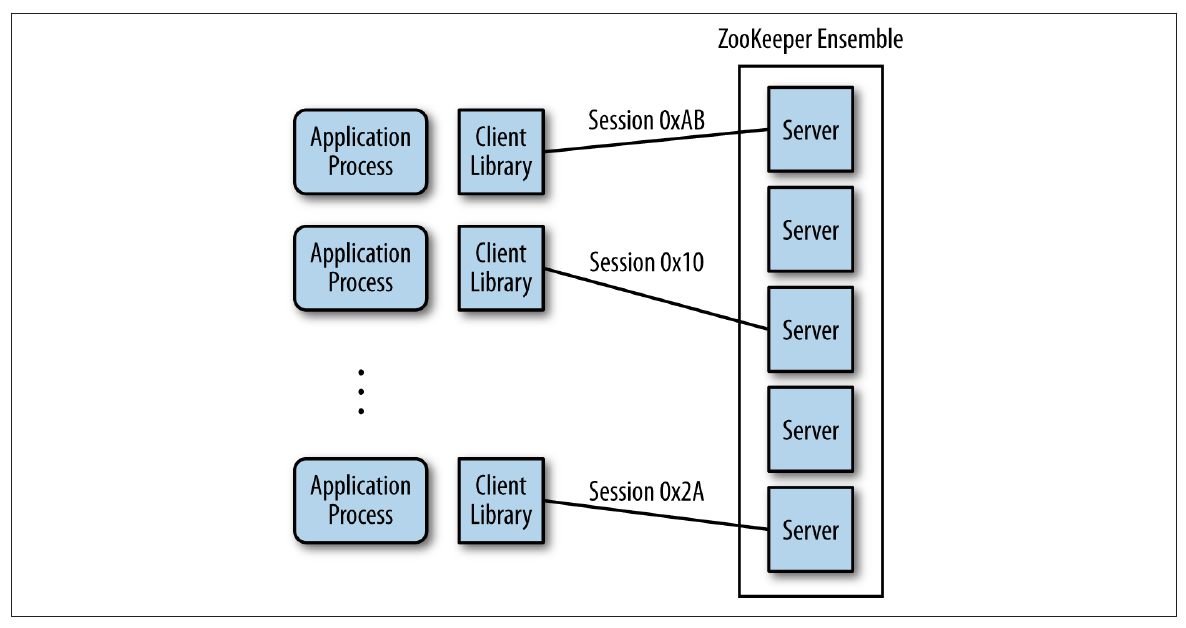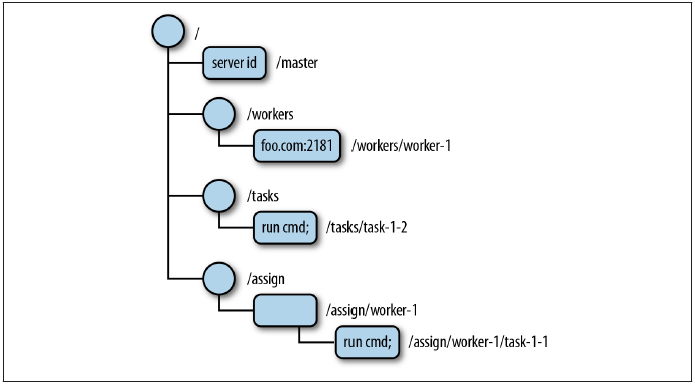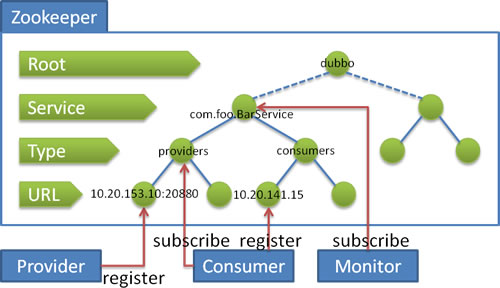This article is more than one year old. Older articles may contain outdated content. Check that the information in the page has not become incorrect since its publication.
Using Zookeeper in Dubbo Applications
Introduction to Zookeeper
Basic Concepts
In modern distributed applications, coordination issues often arise between nodes, including leader election, cluster management, distributed locks, distributed configuration management, unified naming services, and state synchronization. Apache Zookeeper, as its name suggests, is a distributed coordination service framework designed to address these concerns.
To ensure high availability, ZooKeeper can be deployed in a cluster mode, known as a ZooKeeper ensemble. Within a ZooKeeper cluster, one node always acts as the leader, and through the ZAB (Zookeeper Atomic Broadcast Protocol) 1 protocol, it ensures the consistency of information across all nodes. Clients can access any node in the cluster for read and write operations without worrying about data inconsistency.
 Image Credit : ebook -Zookeeper-Distributed Process Coordination from O’Reilly
Image Credit : ebook -Zookeeper-Distributed Process Coordination from O’Reilly
Zookeeper stores data in a manner similar to a traditional UNIX file system, organized in a tree structure where nodes are called znodes (ZooKeeper data nodes).
 Image Credit : ebook -Zookeeper-Distributed Process Coordination from O’Reilly
Image Credit : ebook -Zookeeper-Distributed Process Coordination from O’Reilly
Basic Usage
You can install and run Zookeeper by downloading it directly 2, or on a Mac using Homebrew 3 with brew install zookeeper. This article uses Docker to run Zookeeper for general usability. Please prepare your Docker environment first if it is not installed 4.
1. Start Zookeeper
Run Zookeeper in a Docker container with the following command:
docker run --rm --name zookeeper -p 2181:2181 zookeeper
2. Access the Zookeeper Container
docker exec -it zookeeper bash
The bin directory contains the command to start Zookeeper zkServer and the management console zkCli.
bash-4.4# ls -l bin
total 36
-rwxr-xr-x 1 zookeepe zookeepe 232 Mar 27 04:32 README.txt
-rwxr-xr-x 1 zookeepe zookeepe 1937 Mar 27 04:32 zkCleanup.sh
-rwxr-xr-x 1 zookeepe zookeepe 1056 Mar 27 04:32 zkCli.cmd
-rwxr-xr-x 1 zookeepe zookeepe 1534 Mar 27 04:32 zkCli.sh
-rwxr-xr-x 1 zookeepe zookeepe 1759 Mar 27 04:32 zkEnv.cmd
-rwxr-xr-x 1 zookeepe zookeepe 2696 Mar 27 04:32 zkEnv.sh
-rwxr-xr-x 1 zookeepe zookeepe 1089 Mar 27 04:32 zkServer.cmd
-rwxr-xr-x 1 zookeepe zookeepe 6773 Mar 27 04:32 zkServer.sh
3. Enter the Zookeeper Management Interface via zkCli
Since you started Zookeeper through Docker, the Zookeeper process is already running and is available at port 2181.
bash-4.4# ps
PID USER TIME COMMAND
1 zookeepe 0:02 /usr/lib/jvm/java-1.8-openjdk/jre/bin/java -Dzookeeper.log.dir=. -Dzookeeper.root
32 root 0:00 bash
42 root 0:00 ps
You can directly access the Zookeeper console for management using zkCli.
bash-4.4# bin/zkCli.sh -server 127.0.0.1:2181
Connecting to 127.0.0.1:2181
...
WATCHER::
WatchedEvent state:SyncConnected type:None path:null
[zk: 127.0.0.1:2181(CONNECTED) 0] help
ZooKeeper -server host:port cmd args
stat path [watch]
set path data [version]
ls path [watch]
delquota [-n|-b] path
ls2 path [watch]
setAcl path acl
setquota -n|-b val path
history
redo cmdno
printwatches on|off
delete path [version]
sync path
listquota path
rmr path
get path [watch]
create [-s] [-e] path data acl
addauth scheme auth
quit
getAcl path
close
connect host:port
4. Basic Operations in zkCli
Create the node /hello-zone:
[zk: 127.0.0.1:2181(CONNECTED) 19] create /hello-zone 'world'
Created /hello-zone
List child nodes under / to confirm that hello-zone was created:
[zk: 127.0.0.1:2181(CONNECTED) 20] ls /
[zookeeper, hello-zone]
List child nodes under /hello-zone to confirm it is empty:
[zk: 127.0.0.1:2181(CONNECTED) 21] ls /hello-zone
[]
Get the data stored in the /hello-zone node:
[zk: 127.0.0.1:2181(CONNECTED) 22] get /hello-zone
world
Using Zookeeper in Dubbo
Dubbo uses Zookeeper for service registration, discovery, and configuration management. The organization of data in Zookeeper is illustrated in the following diagram:

First, all Dubbo-related data is organized under the root node /dubbo.
The second-level directory represents the service name, such as com.foo.BarService.
The third-level directory has two subnodes, providers and consumers, indicating the service providers and consumers, respectively.
The fourth-level directory records the URL information of each application instance related to that service. Under providers, it shows all providers of the service, and under consumers, it shows all consumers. For example, the service provider for com.foo.BarService registers its URL information under /dubbo/com.foo.BarService/providers when it starts; similarly, the service consumer registers its information under the corresponding consumers node, and subscribes to the corresponding providers node to be notified of any changes to the service provider address list.
Preparing Example Code
The code for this article can be found at https://github.com/apache/dubbo-samples/tree/master/3-extensions/registry/dubbo-samples-zookeeper.
1. Interface Definition
Define a simple GreetingService interface with a simple method sayHello that greets the caller.
public interface GreetingService {
String sayHello(String name);
}
2. Server: Service Implementation
Implement the GreetingService interface and annotate it with @Service to mark it as a Dubbo service.
@Service
public class AnnotatedGreetingService implements GreetingService {
public String sayHello(String name) {
return "hello, " + name;
}
}
3. Server: Assembly
Define ProviderConfiguration to assemble Dubbo services.
@Configuration
@EnableDubbo(scanBasePackages = "com.alibaba.dubbo.samples.impl")
@PropertySource("classpath:/spring/dubbo-provider.properties")
static class ProviderConfiguration {}
The dubbo-provider.properties file is an external configuration method in a Spring application, with the following contents:
dubbo.application.name=demo-provider
dubbo.registry.address=zookeeper://$DOCKER_HOST:2181
dubbo.protocol.name=dubbo
dubbo.protocol.port=20880
Since Zookeeper runs in a Docker container, it is important to note:
- This article assumes that the Dubbo application runs on the host machine, i.e., outside the Docker container, and you need to replace Zookeeper’s address with the IP address specified by the environment variable ${DOCKER_HOST}. Please refer to the Docker official documentation for details.
- If the Dubbo application is also a Dockerized application, you simply use the container name for Zookeeper, which is zookeeper in this article.
- Of course, if you start Zookeeper without using a container, you can simply change the $DOCKER_HOST here to localhost.
4. Server: Start Service
In the main method, start a Spring Context to expose the Dubbo service.
public class ProviderBootstrap {
public static void main(String[] args) throws Exception {
AnnotationConfigApplicationContext context = new AnnotationConfigApplicationContext(ProviderConfiguration.class);
context.start();
System.in.read();
}
}
When you run the server’s main method, you will see the following output, indicating that the server has started successfully and registered the GreetingService at the registry (ZookeeperRegistry):
[03/08/18 10:50:33:033 CST] main INFO zookeeper.ZookeeperRegistry: [DUBBO] Register: dubbo://192.168.99.1:20880/com.alibaba.dubbo.samples.api.GreetingService?anyhost=true&application=demo-provider&dubbo=2.6.2&generic=false&interface=com.alibaba.dubbo.samples.api.GreetingService&methods=sayHello&pid=12938&side=provider×tamp=1533264631849, dubbo version: 2.6.2, current host: 192.168.99.1
Use the Zookeeper management terminal to observe the registration information of the service provider:
$ docker exec -it zookeeper bash
bash-4.4# bin/zkCli.sh -server localhost:218
Connecting to localhost:2181
...
Welcome to ZooKeeper!
JLine support is enabled
...
[zk: localhost:2181(CONNECTED) 0] ls /dubbo/com.alibaba.dubbo.samples.api.GreetingService/providers
[dubbo%3A%2F%2F192.168.99.1%3A20880%2Fcom.alibaba.dubbo.samples.api.GreetingService%3Fanyhost%3Dtrue%26application%3Ddemo-provider%26dubbo%3D2.6.2%26generic%3Dfalse%26interface%3Dcom.alibaba.dubbo.samples.api.GreetingService%26methods%3DsayHello%26pid%3D12938%26side%3Dprovider%26timestamp%3D1533264631849]
You can see that the just-started Dubbo service registered its URL at the providers node: dubbo://192.168.99.1:20880/com.alibaba.dubbo.samples.api.GreetingService?anyhost=true&application=demo-provider&dubbo=2.6.2&generic=false&interface=com.alibaba.dubbo.samples.api.GreetingService&methods=sayHello&pid=12938&side=provider×tamp=1533264631849.
5. Client: Reference Service
Use @Reference to declare a reference to the service in the client. At runtime, this reference will launch a full call, and the service’s target address will be queried from the provider node in Zookeeper.
@Component("annotatedConsumer")
public class GreetingServiceConsumer {
@Reference
private GreetingService greetingService;
public String doSayHello(String name) {
return greetingService.sayHello(name);
}
}
6. Client: Assembly
Define ConsumerConfiguration to assemble Dubbo services.
@Configuration
@EnableDubbo(scanBasePackages = "com.alibaba.dubbo.samples.action")
@PropertySource("classpath:/spring/dubbo-consumer.properties")
@ComponentScan(value = {"com.alibaba.dubbo.samples.action"})
static class ConsumerConfiguration {}
The dubbo-consumer.properties file is an external configuration method in a Spring application, with the following contents:
dubbo.application.name=demo-consumer
dubbo.registry.address=zookeeper://$DOCKER_HOST:2181
dubbo.consumer.timeout=3000
As with 3. Server: Assembly, you need to modify the $DOCKER_HOST defined in dubbo.registry.address according to your running environment. Please refer to the explanation in step 3.
7. Client: Initiate Remote Call
Run the main method to make a remote call to the already started service provider. Dubbo will first subscribe to the service address from Zookeeper, then select one from the returned address list to call the remote service:
public class ConsumerBootstrap {
public static void main(String[] args) {
public class ConsumerBootstrap {
public static void main(String[] args) throws IOException {
AnnotationConfigApplicationContext context = new AnnotationConfigApplicationContext(ConsumerConfiguration.class);
context.start();
GreetingServiceConsumer greetingServiceConsumer = context.getBean(GreetingServiceConsumer.class);
String hello = greetingServiceConsumer.doSayHello("zookeeper");
System.out.println("result: " + hello);
System.in.read();
}
}
The output is as follows:
[03/08/18 01:42:31:031 CST] main INFO zookeeper.ZookeeperRegistry: [DUBBO] Register: consumer://192.168.99.1/com.alibaba.dubbo.samples.api.GreetingService?application=demo-consumer&category=consumers&check=false&default.timeout=3000&dubbo=2.6.2&interface=com.alibaba.dubbo.samples.api.GreetingService&methods=sayHello&pid=82406&side=consumer×tamp=1533274951195, dubbo version: 2.6.2, current host: 192.168.99.1 #1
[03/08/18 01:42:31:031 CST] main INFO zookeeper.ZookeeperRegistry: [DUBBO] Subscribe: consumer://192.168.99.1/com.alibaba.dubbo.samples.api.GreetingService?application=demo-consumer&category=providers,configurators,routers&default.timeout=3000&dubbo=2.6.2&interface=com.alibaba.dubbo.samples.api.GreetingService&methods=sayHello&pid=82406&side=consumer×tamp=1533274951195, dubbo version: 2.6.2, current host: 192.168.99.1 #2
...
result: hello, zookeeper
Notes:
- Register: consumer://192.168.99.1/…&category=consumers&: The consumer registers its information with Zookeeper under the
consumersnode. - Subscribe: consumer://192.168.99.1/…&category=providers,configurators,routers&: The consumer subscribes to the
providers,configurators, androutersnodes, whereconfigurationsare related to Dubbo configurations androutersare related to routing rules. Notably, the subscription to theprovidersnode means that when new service providers join, the new address list will be pushed to subscribers, allowing service consumers to dynamically perceive changes to the address list.
Use the Zookeeper management terminal to observe the registration information of the service provider:
$ docker exec -it zookeeper bash
bash-4.4# bin/zkCli.sh -server localhost:218
Connecting to localhost:2181
...
Welcome to ZooKeeper!
JLine support is enabled
...
[zk: localhost:2181(CONNECTED) 4] ls /dubbo/com.alibaba.dubbo.samples.api.GreetingService/consumers
[consumer%3A%2F%2F192.168.99.1%2Fcom.alibaba.dubbo.samples.api.GreetingService%3Fapplication%3Ddemo-consumer%26category%3Dconsumers%26check%3Dfalse%26default.timeout%3D3000%26dubbo%3D2.6.2%26interface%3Dcom.alibaba.dubbo.samples.api.GreetingService%26methods%3DsayHello%26pid%3D82406%26side%3Dconsumer%26timestamp%3D1533274951195]
You can see that the Dubbo service consumer registered its URL at the consumers node: consumer://192.168.99.1/com.alibaba.dubbo.samples.api.GreetingService?application=demo-consumer&category=providers,configurators,routers&default.timeout=3000&dubbo=2.6.2&interface=com.alibaba.dubbo.samples.api.GreetingService&methods=sayHello&pid=82406&side=consumer×tamp=1533274951195.
Conclusion
This article focuses on how to use Zookeeper as a registry in Dubbo applications. Additionally, it mentions that Zookeeper also serves as a configuration center and service governance role in the context of Dubbo. The Zookeeper discussed in this article is a single-node, standalone mode; in production environments, to meet the requirement of high availability, a Zookeeper cluster is usually assembled, known as Zookeeper ensemble mode.
Through this article, readers will grasp:
- The basic concepts and usage of Zookeeper.
- The role of Zookeeper in Dubbo applications.
- Practical understanding of the interaction between Zookeeper and Dubbo.
- How Dubbo stores service registration and consumption information in Zookeeper.